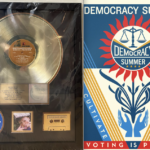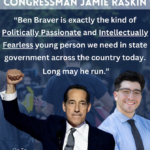Donald Trump has been doing his best to make hay out of Hillary Clinton taking a shot at him for his string of sexist remarks and attacking her for supposedly "playing the woman card" for heaven forbid daring to point out the words that have come out of his mouth while he's been out on the road campaigning for president.
Trump, his allies and enablers in the media have decided the best line of attack to fight back against this is to go after her husband, the former President Bill Clinton, and and to shamelessly try to equate a consensual affair with an adult to Bill Cosby drugging and raping as many as 50 women, as we saw from Tucker Carlson's buddy Jamie Weinstein on Fox this week, and from right wing hack Mark Steyn, who was filling in for Rush Limbaugh on his radio show.
Never mind that Trump actually defended Clinton back in the day and even said that Bill Clinton would be considered a hero if he cheated on Hillary with a supermodel: Trump Defended Clinton During Lewinsky Scandal Against “Moralist” Hypocrites In Congress:
Republican front-runner Donald Trump revived Bill Clinton’s past marital indiscretions this week, attacking Hillary Clinton on Twitter and on TV for playing the “women’s card” and saying her husband’s past affairs would be fair game.
Trump took a different tact in the late ’90s, when the scandal was at its peak, defending then-President Bill Clinton against the “moralists” and hypocrites in Congress and arguing that the scandal wouldn’t have been that bad if only Clinton had chosen to carry on an affair with a supermodel instead.
“I got a chuckle out of all the moralists in Congress and in the media who expressed public outrage at the president’s immoral behavior,” wrote Trump in The America We Deserve . “I happen to know that one U.S. senator leading the pack of attackers spent more than a few nights with his twenty-something girlfriend at a hotel I own. There’s also a conservative columnist, married, who was particularly rough on Clinton in this regard. He also brought his girlfriend to my resorts for the weekend. Their hypocrisy is amazing.”
Trump also wrote that Clinton should have refused to talk about his personal life.
“When confronted with the Lewinsky matter, Clinton should have stoutly refused to discuss his private life,” wrote Trump. “He should also have declined to answer, rather than perjure himself. If the Clinton affair proves anything it is that the American people don’t care about the private lives and personal of our political leaders so long as they are doing the job.” [...]
In another Times story in 1999, Trump said Clinton would have been considered a hero if he cheated with a supermodel:
For example, Trump disapproves of President Clinton’s behavior in the White House over the past four years, though he suggested that he was bothered less by what Clinton did, than by whom he did it with.
“It was his choice,” Trump said. “It was Monica! I mean, terrible choice.” Trump, who showed off fashion magazines displaying cover-art of the latest in a line of models he has dated, suggested that if Clinton had confessed an improper relationship ( Trump offered a more earthy phrase to get the idea across) with a supermodel, as a opposed to a White House intern, “he would have been everybody’s hero.”
“I’m not making any justification for cheating on your wife,” added Trump, whose own extracurricular marital activities have been a tabloid staple.
Trump of course is singing a different tune today, now that he's pandering to the GOP's right wing base and their blind hatred for both the former Secretary of State and for President Obama.
If the reaction to the right going after Bill Clinton back in 1998 is any indication of how voters and the public in general may react to Trump's attacks now -- and I'm talking the general electorate, not right wing nutter GOP primary voters -- Trump may want to be careful where he treads with this latest line of attack and the possibility of it backfiring on him.
Here's an excerpt from Joe Conason and Gene Lyons' book, The Hunting of The President, (which you can download for free at the link provided) with a reminder of how the public responded to the "vast right wing conspiracy" against the Clintons back in the day.
The Clintons, Their Enemies, And The American Public
Until the remarkable events of January 1998, none of the efforts to bring about the political destruction of Bill and Hillary Clinton appeared to have any chance of succeeding. His enemies’ relentless intrusion into the president’s intimate life, the continuing examinations of his family and political finances, and the ever-expanding investigations of his administration had failed to find sufficient credible evidence to prevent his election and then his reelection, to bring about his impeachment, or to sustain a civil lawsuit against him. Similarly, Hillary Clinton’s oft-predicted indictment was by that time little more than a partisan daydream.
Despite several years of effort and many millions of dollars expended by teams of investigative reporters, two independent counsels, and multiple congressional inquests, in addition to the probes privately financed by Richard Mellon Scaife and other political adversaries, no prosecutable offense had been found. Although independent counsel Kenneth Starr was still keeping that secret to himself for the time being, the most heavily investigated couple in the United States had emerged unscathed. Nearly four years of costly litigation by the Paula Jones legal team had produced a weak case that would not withstand summary judgment.
Yet the hunting of the president had inflicted a severe trauma on him, his family, his friends, his administration, and more broadly on the political culture of American democracy. It had perverted the law and debased the media, and in the months to come it would cost the nation still more. Despite his reckless and foolhardy behavior, the looming threat of impeachment had not been created by Clinton alone—as his enemies, seeking to obscure their own complicity, would stridently insist.
The separate strands of the rope with which those bitter foes had so long hoped to hang him—Paula Jones’s civil lawsuit and Kenneth Starr’s ever-expanding criminal prosecution—were each too weak to bear any such constitutional weight alone. But during the bleak early days of January those two threads had been cunningly twisted together to form a noose, which the president then pulled over his own head.
Most of the country’s citizens refused to join the lynch mob. To the astonishment of Clinton’s critics, public support for the endangered president actually grew in the weeks after the Lewinsky story was exposed. A poll commissioned by CNN and the Wall Street Journal in early February 1998 recorded an astonishing 79 percent of respondents favoring him. That level of support could not be sustained indefinitely, particularly not when Clinton was forced, after eight months of denials, to admit that he had been lying about his relationship with Monica Lewinsky. Yet even then his standing with the public still remained surprisingly high.
Lacking the legitimacy that would have been conferred by popular demand, the Republican right’s anti-Clinton crusade was a lost cause months before the Congress actually voted articles of impeachment against the president. As the national consensus emerged and held firm, disgruntled pundits suggested that the American people had been lulled into moral decadence by years of prosperity. Perhaps Clinton’s popularity would have plunged, too, had the stock market done the same. But clearly there were other significant cultural and political factors that served to protect him.
In 1992, when Gennifer Flowers got her first taste of national fame, more than two-thirds of the electorate had told pollsters that they didn’t believe the media ought to be exploring politicians’ sex lives. Six years later, despite their fresh disappointment in Clinton, there was never any indication that the voters had abandoned that preference for privacy.
Instead it appeared that the more they thought about it, the more the great majority of Americans resented not just Clinton’s misconduct, but everything about the Lewinsky affair: a young woman betrayed by an older friend; a zealous, puritanical, and clearly partisan prosecutor using illegal tape recordings to snare the young woman; the OIC’s attempt to bully her into betraying her lover by threatening her family and feeding smutty leaks to an insatiable news media; and the delight of so-called conservatives in stripping the last vestiges of dignity from the president of the United States.
Many found the very idea of a federal sex investigation abhorrent; they feared that anything that might be done to Bill Clinton and Monica Lewinsky could certainly be done to them.
Even as millions of television viewers became engrossed in the nightly soap opera that Clinton had made of his own life, most of them wisely assessed the complexity of his character and rejected the shrill calls for his resignation or removal. The people who had re-elected him continued to regard Bill Clinton as a flawed but highly capable and essentially decent man, with a bad weakness regarding women—a trait that hardly made him unique in the nation’s capital or anywhere else.
Perhaps just as importantly, many Americans sensed the Lewinsky scandal’s true origins even though very few knew anything specific about them. After nearly six years of confusing headlines and constantly shifting Whitewater accusations, they no longer took the scandal’s premises very seriously. There had been far too many “critical phases” and false alarms in Starr’s investigation. The legalistic maneuvering by which the independent counsel transformed his interminable probe of a twenty-year-old real estate deal into a sexual inquisition struck the majority as intrinsically suspect.
Hillary Clinton’s televised remarks about a “vast right-wing conspiracy to undermine my husband” were initially mocked by pundits as a feeble defense of her husband’s bad character. Yet subsequent revelations about the OIC’s behavior lent weight to her accusation. Rather belatedly, through reporting by Jill Abramson and Don van Natta, Jr., of the New York Times, and later Newsweek’s own Michael Isikoff, enough details emerged about the secretive machinations of Lucianne Goldberg, Linda Tripp, Richard Porter, George Conway, Ann Coulter, and Jerome Marcus to buttress the First Lady’s allegations. By then there was little argument about the existence of a “conspiracy,” and still less about whether the plotters were “right-wing.” Only the “vastness” of their enterprise remained in question.
Forced to answer questions most Americans felt he should never have been asked, Bill Clinton had lied to protect himself, his marriage, his daughter, Monica Lewinsky, and his “political viability”—to choose the meanest way of putting it—from the consequences of his all-too-human frailty. But his shame posed little danger to the republic; his falsehoods and evasions were no threat to the Constitution. His behavior was shameful but hardly felonious, most of his fellow citizens believed, and certainly not in the category of impeachable offenses.
As always, Bill Clinton was also fortunate in his enemies. If Kenneth Starr’s legal judgment was imperfect—in the end, his office lost three out of four jury trials—his political instincts were yet worse, as were those of the independent counsel’s most fervent supporters. Morally certain that Clinton was on the verge of ruin, they hurt their own cause more with each clumsy attempt to strike the fatal blow.
Each successive decision was worse than the one that came before: the incessant leaks about the Tripp tapes and the Lewinsky grand jury; the obsessive prurience of the Starr Report; the insistence of congressional leaders on releasing the independent counsel’s complete investigative files; the decision to broadcast the president’s August 17, 1998, grand jury testimony; and finally the precipitous, party-line vote on articles of impeachment in the lame-duck House of Representatives. These tactics succeeded in damaging Clinton’s personal reputation. Politically, however, the public sympathy they provoked only made him steadily stronger.
As the ideological motivation of Clinton’s enemies became clearer, their isolation became inescapable. Americans of all persuasions were disturbed by Clinton’s behavior, but the most insistent voices calling for his removal—and most often speaking in southern accents ironically like his own—were heard from the precincts of the religious right.
Organizations such as Citizens for Honest Government, Citizens United, and the Council for National Policy received scant notice in the months leading up to the impeachment vote, while characters like Justice Jim Johnson remained discreetly out of sight. But Richard Mellon Scaife and the Arkansas Project gained considerable notoriety, and figures such as the Reverend Jerry Falwell and Georgia representative Bob Barr appeared on television nearly every night.
Barr did not serve their cause well when he characterized the effort to remove the president as a “civil war,” nor when he lectured a distinguished black federal judge testifying before the House Judiciary Committee that “real Americans” favored impeachment.
Such incidents and personalities helped frame the impeachment debate in terms of earlier cultural and political clashes, ranging from the Scopes trial of the Twenties to the civil rights movement of the Sixties. Both the nature and the agenda of the forces aligned against Bill and Hillary Clinton made most Americans determined to deny them a victory. Having at last instigated the “culture war” for which they had long been yearning, the theological warriors of the religious right were chagrined to find themselves decisively outnumbered.
What ordinary citizens seemed to distrust most, however, as the Lewinsky affair unfolded, was the blatant collusion between the Office of Independent Counsel and prominent members of the Washington press corps. It was hard not to notice that the same reporters and news organizations that had been most critical of Clinton in the Jones and Whitewater cases also routinely scooped their rivals during the frenzied weeks that followed the revelations of January 21. Starr’s denials that he and his staff were illegally passing along grand jury evidence in order to put pressure on witnesses and gain political advantage were widely disbelieved. The likelihood that reporters, editors, television correspondents, and producers were repeatedly fabricating attributions like “sources in Starr’s office” and “Starr’s investigators” seemed vanishingly small.
“What makes the media’s performance a true scandal,” wrote media critic Steven Brill, “a true example of an institution being corrupted to its core, is that the competition for scoops so bewitched almost everyone that they let the man in power write the story—once Tripp and Goldberg put it together for him.”
Perhaps the most telling moment in that performance received far less attention than it should have. During a legal battle with the president’s lawyers over his office’s alleged violations of the rule forbidding prosecutors from leaking confidential grand jury information, the Office of Independent Counsel invoked a doctrine of “informant’s privilege” to shield its dealing with the press from judicial scrutiny. What Starr sought to hide wasn’t merely information he had given to reporters; he rather sought to conceal information that reporters had given to him. The identities of his alleged journalistic accomplices were redacted from those portions of Starr’s brief released to the public. Scarcely a word of demurral was heard in the press about journalists gathering information from sources or colleagues ostensibly for their own purposes, and then handing that evidence over to a prosecutor for very different uses. Not only did no reporters or news organizations step forward to explain themselves, but the topic went almost unmentioned.
Nevertheless, most Americans intuitively understood exactly what was happening. As the most powerful and largely unaccountable institution in American public life, the Washington press appeared to have joined forces with a partisan prosecutor to void the results of two presidential elections. This overreaching was more bitterly resented than many in the media realized. Whatever the American people thought and felt about Bill Clinton’s private behavior, they refused to forfeit their constitutional right to choose their chief executive to what they regarded as a ratings-driven coup d’etat.
When that democratic consensus was ratified, against all expectations, during the midterm elections of November 1998, American politics began a gradual withdrawal from the terrible scorched terrain of the previous decade. The old hatreds would linger but, as the desultory impeachment trial in the Senate made clear, their force was almost spent.
Within a few months, the entire episode took on the feeling of a fading nightmare. The media would move on to other wars and tragedies. The Independent Counsel Act would be left to expire by both parties, whose leaders sought to erase the embarrassments of recent years. The scandal culture, feeding on the sins and sorrows of public figures, would probably endure. But after ten years the Clinton scandals, at least, were over.




















